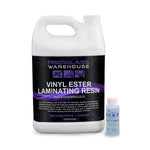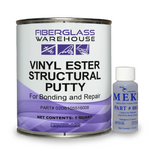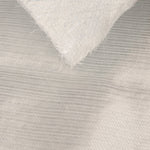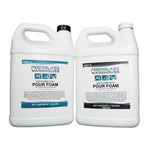You have no items in your shopping cart.
There are endless project possibilities when using fiberglass reinforcements such as fiberglass cloth, fiberglass mat, carbon fiber or aramid. Combine a reinforcement with a polyester, vinyl ester or epoxy resin and it will create a strong durable part. Whether you are in the marine, aerospace, automotive, or construction industry or just a do-it-yourself hobbyist, there are a vast number of things you can do with fiberglass and resin.
Fiberglass reinforcements come in a variety of weights and weaves that produce different strength properties. Fiberglass cloth/fabric is available in weights as low as .75 oz. per square yard. The most popular sizes range from 4 oz. up to 10 oz. per square yard and are typically 38, 50 or 60 inches wide. It comes in several weaves such as plain, twill and satin. Fiberglass cloth tape is a fiberglass cloth made in narrower widths including 1”, 2”, 3”, 4” and 6”. Chopped strand mat, also known as fiberglass mat, is made up of short fiberglass strands that are held together by a styrene binder. When combined with polyester or vinyl ester resin, the strands can be moved around making it ideal for conforming to tight curves and corners and in creating molds. Carbon fiber is a high-strength, great-looking fabric that is popular in the auto industry. It is lightweight and should be used with epoxy resin. Aramid, also known as Kevlar, is known for its great impact, heat and abrasion resistance. There are also heavier fabrics such as woven roving that comes in 18 or 24 oz weights and knitted fabric that is bundled and stitched together.
The main resins used in the composite industry are polyester, vinyl ester and epoxy. Polyester resin is the least expensive and is the most widely used. It has different grades including DCPD, ortho, ISO and surfboard resin. Vinyl ester resin is a higher-grade resin than polyester. It absorbs impact better than polyesters. It also has more resistance to solvents and water degradation. Epoxy resin is the highest grade of the three types of resins, but is the priciest. It is the strongest of the three resins and is good for high performance and lightweight parts. It also has great bonding capability and flexibility.
While there are hundreds of things fiberglass and resin can be used for, we have narrowed it down to the four most popular categories. The top four uses are new fiberglass construction/fabrication, waterproofing, repairing holes, cracks, and other damage to fiberglass parts and creating large fiberglass molds.
Fiberglass Construction/Fabrication
One of the biggest advantages of using fiberglass reinforcements with resin to fabricate or construct with is that it creates lightweight and strong parts. Fiberglass and resin have been used to construct many things including boats, surfboards, cars, planes, bike frames, and even furniture. Fiberglass is also popular because it is economical and it can be molded into many shapes and designs during the lamination process.
As stated above, fabricating items with fiberglass and resin is fairly low cost. It is more cost effective than using materials such as steel, aluminum, and metal. It also has great fatigue properties and durability.
Waterproofing- Using Fiberglass Reinforcements and Resin
Another common use of fiberglass and resin is waterproofing. This includes boat hulls, boat decks, house decks, pools, and more. Fiberglass reinforcements are not completely waterproof by themselves but when combined with resin, especially a vinyl ester, a water barrier is created.
Polyester resin can be used on surfaces that won’t have standing water or be in the water all of the time. It’s important to use a vinyl ester or marine grade resin when making items designed to be submerged in water. Polyester over time will let some moisture in whereas vinyl ester or epoxy will have a better water barrier.
Repairing Holes, Cracks, and other Damage to Fiberglass Parts
Holes, cracks, and other damage to fiberglass parts can be repaired using the same materials used in the original construction of the part. Fiberglass cloth or mat combined with resin can make a strong repair. The repair can be finished up by using gel coat to match the surrounding area.
Common items needed for a repair are a polyester finishing resin, MEKP catalyst, fiberglass cloth, chopped strand mat, a mixing pot, stir sticks, a fiberglass laminating roller, squeegee, acetone and fumed silica (or other filler). You will also want some safety items such as a pair of safety goggles and gloves.
Important note: Polyester resin does not adhere to epoxy resin but epoxy resin can adhere to polyester. If the part needing to be repaired is made with epoxy resin, do not use polyester resins. Also, chopped strand mat is not compatible with epoxy resins. If you decide to do the repair with epoxy, use a fiberglass cloth of knitted fabric.
Creating large Fiberglass Molds
Another common use for fiberglass and resin is creating molds. Fiberglass molds are ideal when replicating a larger part or when the mold will be used over and over again to produce multiple parts. First off, you will need a plug which is the exact dimensions and shape as the part you want to make. This can either be made form scratch or can be an existing part such as a car bumper. The plug will need to be sealed if it is porous.
The mold making process uses a mold release agent such as Partall Paste #2 and PVA #10, a tooling gel coat, fiberglass and resin. Once the plug is well coated with mold release, a tooling gelcoat can be used. While gel coat is ok to use, a tooling gel coat is ideal because it is stronger and more scratch-resistant. Chopped strand mat is preferred for the first layer to prevent any print through followed by more mat or fiberglass cloth layers. Polyester ortho or ISO resin can be used to create the mold.
If the mold is well taken care of using polishing agents and mold releases, it can last for a very long time. Many parts can be fabricated with a good fiberglass mold making it a great option.
Conclusion
If you are fabricating a new part, waterproofing, repairing a fiberglass part or making a fiberglass mold, and decide fiberglass is the route you want to take, there are lots of resins and reinforcements available. Make a list of the most important things for your project. Whether that is weight, strength, corrosion resistance, water resistance etc. This will help you choose which resin and reinforcement will work the best for you. Bottom line, fiberglass reinforcements and resins are a great choice for your next project.
**It is important to always take safety precautions when working with fiberglass and resin. Always work in a well-ventilated area. Wear gloves, safety goggles and a respirator. To protect your clothes and skin, wear some protective clothing. You can check out our safety page for items we carry.
**For more detailed info on fiberglass reinforcements and resins, visit our Ultimate Fiberglass and Resin Guide. Or, feel free to contact us at sales@fiberglasswarehouse.com. Our customer service team is happy to help with any questions you might have.
**Be aware that working with fiberglass and resin can be more of an art than a science.









